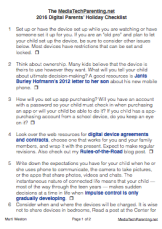
Every 21st Century parent needs a holiday digital parenting checklist that describes the tasks to accomplish between purchasing a new digital device and watching a child gleefully unwrap it. A list gives parents a head start, helping them understand challenges, set explanations and guidelines, anticipate problems, and most importantly, set the stage for responsible and respectful use of extraordinarily powerful devices.
Many parents I speak with point out how little time they have to go through this sort of checklist — but the time spent now is nothing compared the time drain that occurs after your child experiences a connected world problem. It’s worth your time to consider the checklist now.
The MediaTechParenting 2015
Digital Parents’ Holiday and Beyond Checklist

- Open the device, set it up and then play around enough to become familiar. You don’t need to know everything — your child will discover lots more fairly quickly — but as a parent you need to know basic information about the item you are handing to your child.
- Have a trusted adult friend set it up for you — while you watch — if you really cannot do it by yourself.
- Most devices have restrictions that can be set and locked. If you are purchasing one of the wonderful robots or communication devices, be sure to think about how much personal information your child needs to provide.
- Think about ownership. Many kids believe that the device, especially a mobile phone, is theirs to use however they choose. What will you tell your child about ultimate decision-making? A good resources is Janis Burley Hofmann’s 2012 letter to her son about his new mobile phone.
- How will you set up app purchasing? Will you have an account with a password so that your child must check in when purchasing an app or will your child be able to do it independently? If you child has a app-purchasing account from a school device, do you keep an eye on it?
- Look over the web resources for digital device agreements and contracts, choose one that works for you and your family members, and wrap it with the present. Expect to make regular revisions and encourage collaboration. Also check out my Rules-of-the-Digital-Road blog post.
- Write down the expectations you have for your child when he or she uses the phone to communicate, the camera to take pictures, or the apps to share photos, videos and chats. The instantaneous nature of connected life means that your child — most of the way through the teen years — makes sudden, potentially public decisions at a time in life when impulse control is only gradually developing.
- Consider when and where family members will charge devices. Charging devices in bedrooms is unwise. Read a post at the Center on Media and Child Health (CMCH) about promoting sleep and getting media devices out of kids bedrooms.
- Decide where and when devices will be used and not used in your family. Our conversation skills are going down hill, so be sure that your family has plenty of time for interesting face-to-face conversations. Read Sherry Turkle’s new book, Reclaiming Conversation or check out my October 2015 blog post that includes some of the reviews for Turkle’s book.
- Plan to talk about anonymity — before your child leaves the house with the device. It’s critical for young people to understanding that anonymity, in truth, does not really exist even though it sometimes feels like it does. Read Most Teens Don’t Use Anonymous Apps: Advice for Those Who Do over at ConnectSafely.org.
- Know what digital knowledge your child should possess and at what age various concepts should be understood before using a digital device. Check out Digital Literacy 101 For Kids, a post that describes the connected-world information that children should master before receiving a digital device.
- Think about how you model for and mentor your child. Do you use the mobile phone in the car? Do you ask your child to wait when you are responding to an email or text? Do you use a phone at a family meal? Do you use one at a child’s assembly presentation or athletic event? Children are more likely to imitate what we do rather than what we say. After all your goal is to promote health and wellness for everyone in your family, and digital wellness is one part of that.
 Digital parenting is a challenge. Many of us mentor and guide our 21st Century children on issues and topics we wish we knew more about (or at least as much as the kids do) but according to a recent study commissioned by the Family Online Safety Institute (FOSI), parents report that they are feeling more and more confident about managing digital kids when they use technology. Moreover, on the whole, parents worry less and feel more positive about the various ways that technology affects their children.
Digital parenting is a challenge. Many of us mentor and guide our 21st Century children on issues and topics we wish we knew more about (or at least as much as the kids do) but according to a recent study commissioned by the Family Online Safety Institute (FOSI), parents report that they are feeling more and more confident about managing digital kids when they use technology. Moreover, on the whole, parents worry less and feel more positive about the various ways that technology affects their children.
What’s important to remember anytime you do not feel quite sure of yourself is that while our understanding about any specific device may ice minimal, we know exactly how we what our children to mature and grow into thoughtful and responsive citizens.
“We have to parent in the digital. We can’t just say, ‘I don’t get it.’ “
Michael Rich, MD, Center on Child & Media Health, Boston Children’s Hospital



One thought on “After Buying a Device & Before Giving It to Kids: What to Do”